Substance Testing on the Dance Floor with a Mobile High-tech Lab
v1.1 - Aug 5, 2010
Originally published as a poster for Club Health 2010
Citation: Allemann D, Pauli H, Mürner A, et al. "Substance Testing on the Dance Floor with a Mobile High-tech Lab". Club Health 2010, Poster. Jun 2010.

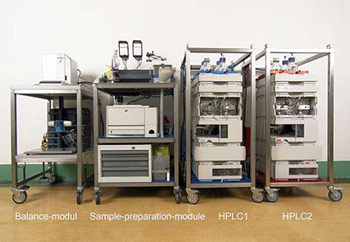
|
Introduction
Since 1998 the mobile lab unit of the Office of the Cantonal Pharmacist (Health & Social Welfare Department, State of Bern, Switzerland) has been testing so-called "party drugs" on the dance floor. At more than 100 events, the team has analyzed over 1700 samples in cooperation with "Streetwork Zürich" and "Contact Bern". The mobile lab consists of four custom-made sub-units mounted in steel-framed racks on wheels, one for weighing and documentation, one for sample preparation and two with the equipment for chemical analysis (HPLC-DAD).The lab is operated by two experienced technicians. Before analysis the interested customer is asked by the lab crew to fill out a questionnaire concerning information about the sample; thereafter every sample is digitally documented and characterized by physical appearance (form, weight, dimensions etc.).
Flow diagram
Detailing collaboration between the on-site prevention team and the laboratory.
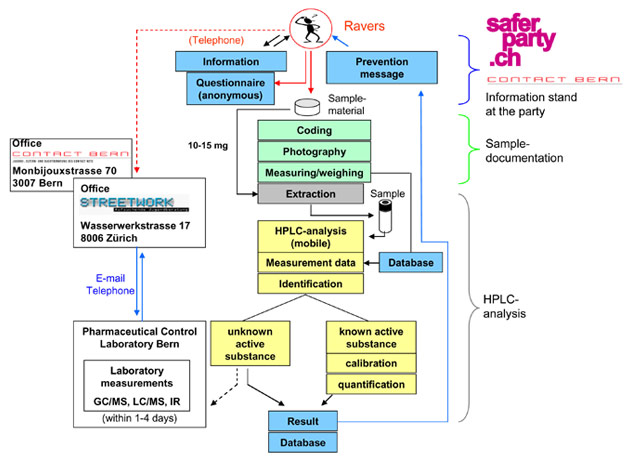
|
Chemical analysis requirements
Chemical analysis of party drugs gives one of three possible results. The findings may be a single active agent, several active agents, or indeed no active agent. Reliable analysis of the substances in a sample cannot be achieved by means of a simple "quick test" and is only possible by the use of a complex measurement chain, as shown in the following basic diagram:

|
Sample preparation:
Due to the very sensitive analytical methods, only a representative part of the sample is used for further analysis. Sample preparation is quick and effective. The material is pulverised in a mortar and dissolved in methanol with the aid of an ultrasonic extractor. An internal standard is added as control. In most cases this extract still contains insoluble components, which must be filtered off before analysis. The clear sample solution obtained is transferred into a sample vial.

|
HPLC (measurement apparatus)
For chemical analysis of party drugs, separation and detection of different constituents of mixtures (active ingredients and fillers) is necessary. With the mobile lab we use High Performance Liquid Chromatography (HPLC) for the separation process. Our computer-controlled HPLC systems are equipped with DAD/UV-Vis Spectrometers (DAD=Diode Array Detector).
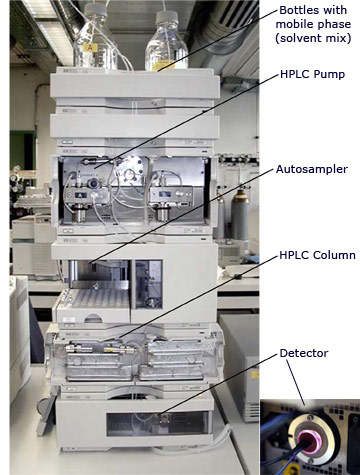
in close-up, bottom right. |
HPLC Pump
(Part of the separation system). This high-pressure pump delivers the solvent (with the dissolved sample) through the separating column to the detector.Autosampler
The autosampler transfers the prepared sample from the vial into the measurement apparatus.HPLC column
The "central unit" of the HPLC system serves to separate dissolved mixtures of substances into their constituents.Detector
The chemical detector is positioned at the end of the column. It is the highly sensitive "eye" of the measurement chain and records substances which absorb ultraviolet light when they pass through the detector cell dissolved in the mobile phase. The detector provides two kinds of information about the molecules measured: their identity and their quantity. The whole process is continuously monitored with a computer system. Measurement signals are converted into graphical displays appearing on the computer screen. The two most important displays are the chromatogram and the UV spectrum. The chromatogram is a representation of the separation process. The UV spectrum is a characteristic constant for a particular substance.Analytical method
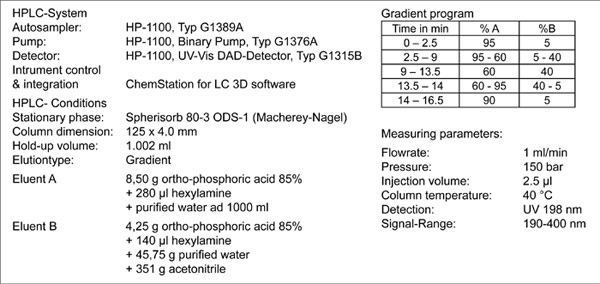
|
Report
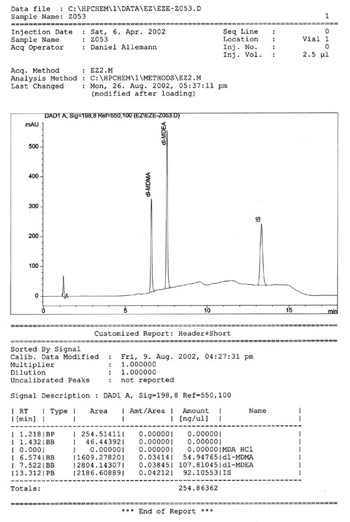
|
Header:
The header contains details like: Filename, sample ID number, date of analysis, name of method, etc.Chromatogram:
The chromatogram is a graphic visualisation of the separation process. Detected substances appear as "peaks".Results (identification and quantification):
The system compares the area-value of an integrated peak with the corresponding calibration of the active substance in the specified methods. This automatic process gives us a precise quantification.Additionally, it is possible to get the UV spectra of the peak and compare it with our specific UV spectra library.
Results
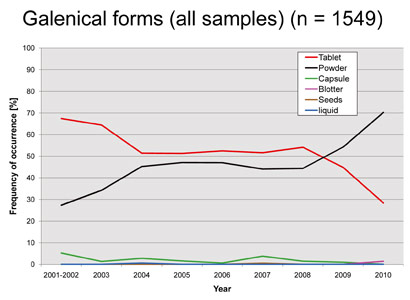
blotter, seeds and liquid (all samples). |
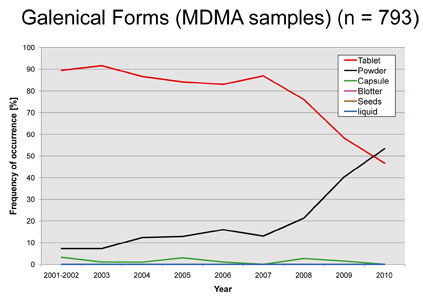
(MDMA samples). |
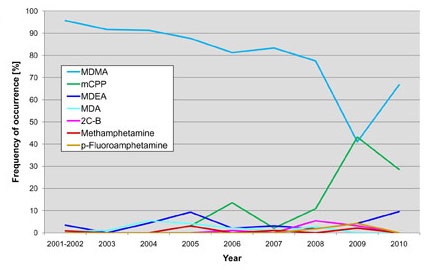
in tablets tested (n=820). |
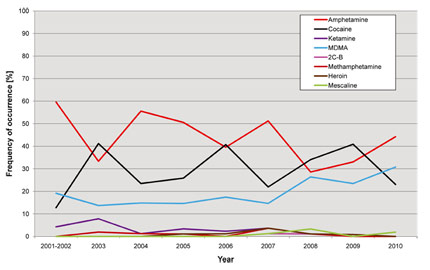
in powders tested (n=694). |
Quantitative comparison
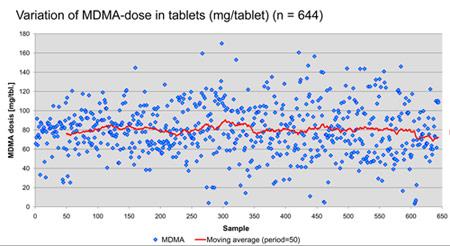
|
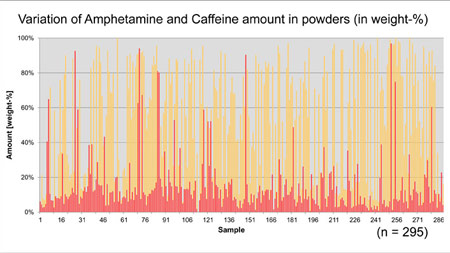
|
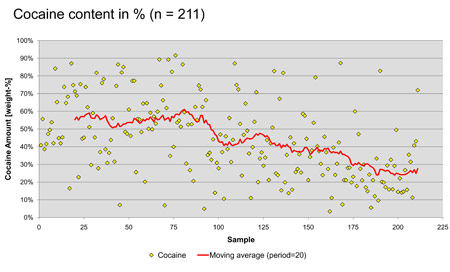
|

|
Qualitative results
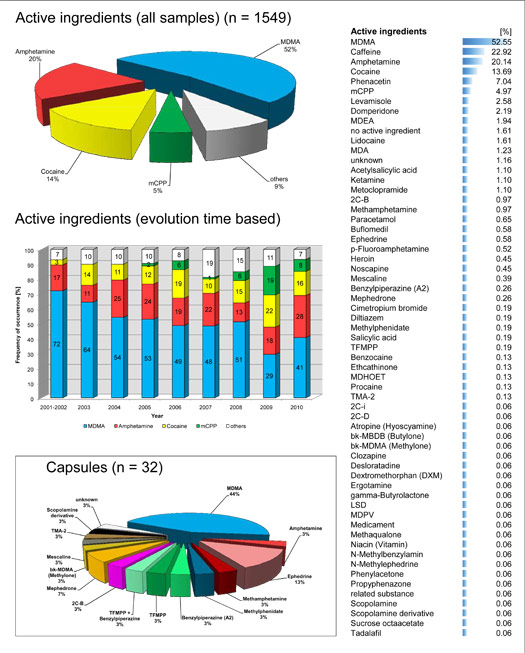
|
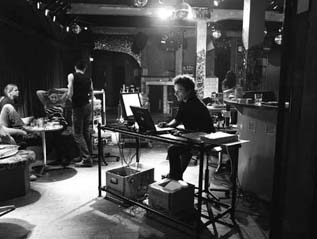
|
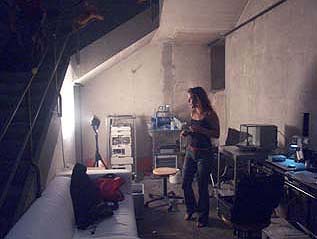
|

|
Links #
- Substance Testing on the Dance Floor with a Mobile High-tech Lab (PDF), Poster for Club Health 2010
- Health & Social Welfare Department, State of Bern, Switzerland
- Jugendberatung Streetwork [Streetwork Youth Counseling]
- Contact Bern
Notes #
|
Contacts: Dr. H.-J. Helmlin, MBA, PhD Head, Laboratory KAPA State of Bern Baltzerstrasse 5 CH-3012 Bern, Switzerland e-mail: hans-joerg.helmlin (at) gef.be.ch Daniel Allemann Laboratory KAPA State of Bern Baltzerstrasse 5 CH-3012 Bern, Switzerland e-mail: daniel.allemann (at) gef.be.ch |

|
Photo Credits #

